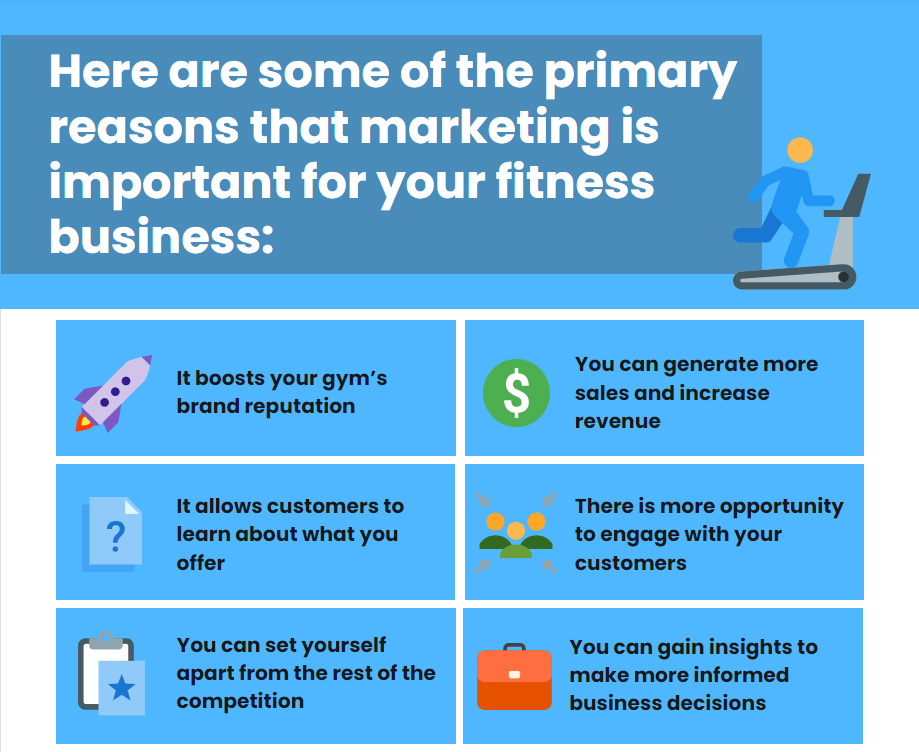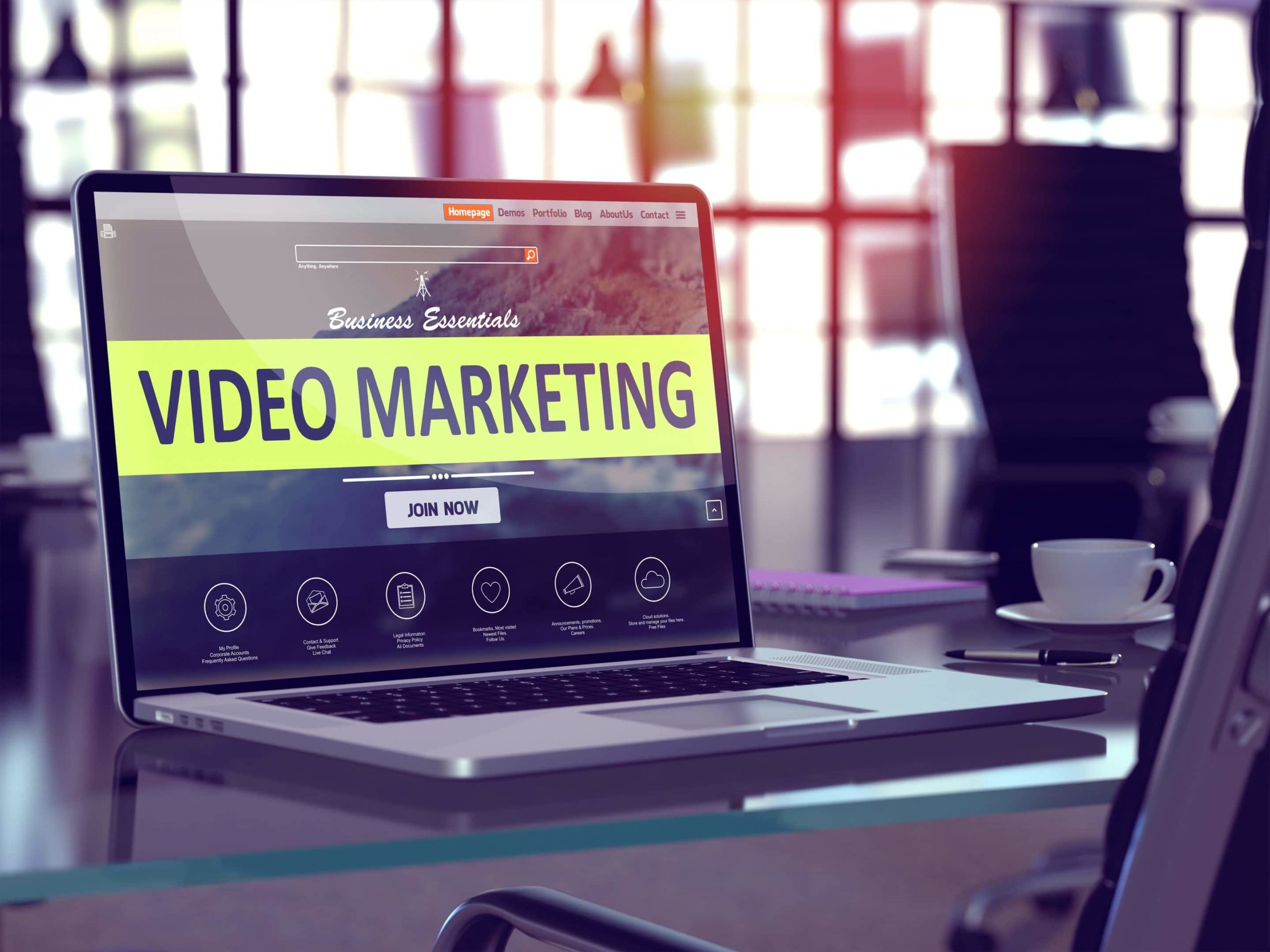The fitness industry is becoming more and more competitive each day. It’s critical to stay up to date with current trends, evolving interests, and new technology. The competition has never been stronger.
So what are you currently doing to set yourself apart from every other gym, fitness center, or health club out there? Do you know exactly what your customers are looking for? Are you providing as much value as you possibly can?
You might be doing any number of things. But are they working the way you expected or are you not seeing the type of return you hoped for? Have you been putting a ton of effort into a strategy that isn’t providing a tangible return?
No matter the type of fitness business you operate, marketing it effectively is what can help take your business to the next level. So what do you need to know and where do you start?
Having an effective marketing strategy in place will help lead to longer, more sustained growth.
You have come to the right place to find out everything that you need to know. Keep reading to find out more about fitness marketing, why it’s important, and 11 actionable strategies you can use. Before you know it you will build and establish a strong brand identity and engage new customers.
What Is Fitness Marketing?
Marketing, in general, is all about getting your brand message across effectively and getting it in front of the right audience. Fitness marketing works in the same way. When you can highlight your business, the benefits you provide, and the value you offer, you’re going to attract the right audience.
Plus, you will be able to attract that audience at the right time.
Basically, the fitness marketing that you do is how you sell and promote the services you offer. A marketing strategy is key for any type of business and it can include several different moving parts. For example, some of these parts might include:
- Email marketing
- Content marketing
- Social media marketing
- Search engine optimization (SEO)
- Direct marketing
- Influencer marketing
- Paid advertising
And within each of these moving parts there can be separate, targeted strategies.
But everything will typically start with market research to better understand your audience and what they are looking for. By analyzing your market, you get a better sense of the different ways your customers want to engage with your gym.
Doing this lets you determine the most effective way to engage with them.
There is no sense in wasting valuable time and money on strategies that aren’t going to provide you a return. When you understand your audience, you can tailor your strategy to maximize its effectiveness.
How Competitive Is Digital Marketing in the Fitness Industry?
Digital marketing in general is now arguably the go-to marketing strategy for brands. It’s an essential component of not only targeting the right audience but generating revenue and establishing brand authority.
Without digital marketing, it can be easy to get lost in the competitive landscape. This will lead to missed opportunities that you otherwise would be able to capitalize on.
Digital marketing has grown incredibly over the past five to ten years. And the crazy part? It’s showing no signs of slowing down. There is no shortage of ways for you to leverage the power of digital marketing. It’s a powerful way to find the right customers and provide them with the most value.
Here are a few digital marketing statistics to help paint the picture a little clearer:
- When you document your marketing strategy, you are 313% more likely to see success compared to if you didn’t
- 75% of marketers have increased their overall trust and credibility with effective digital marketing tactics
- 74% of global internet search traffic comes directly from Google
- Video is expected to make up almost 83% of the world’s internet traffic by 2023
- More than half of the world’s population is active on social media
- Less than 1% of people who search on Google will scroll to the second page
- After reading a blog post about a product, readers are 60% more likely to purchase that product
These statistics are only a small sample of the power of digital marketing. But as you can see, the benefits that come from an effective marketing strategy can help set your gym business apart from the rest of the competition.
Why Is Marketing Important for Your Fitness Business?
You might have state-of-the-art equipment and facilities, qualified trainers, and a wide range of fitness classes. But do customers know that you provide this type of value? Do they know the benefits that they can get from coming to your gym?
Some might, but how are you highlighting and promoting everything you offer to a wider audience?
Everything about your gym business revolves around reputation, relevance, and retention. A marketing strategy helps market these details correctly and to the right audience. It’s all centered around the view your customers have of your gym.
When you have a strong brand and are able to showcase that to your target customer base, you can attract new customers and increase customer retention.

There isn’t a perfect, one-size-fits-all approach to a marketing strategy. You have to do the right research to find out exactly what your customers are looking for. But the good news is that once you have that information you can start to develop an actionable marketing strategy.
How Do You Make Fitness Marketing Effective?
Connecting with your customers is essential. It’s what sets the foundation for any type of marketing strategy. But even though each marketing strategy is going to have varying methods and techniques, the core of a marketing strategy is going to follow a few similar things.
- Understanding your target audience. Knowing who your audience is and what they want is how you’re going to craft your brand messaging to engage with them. You can dive deep into this by finding out their education, interest, demographic, and other types of behavior.
- Sending the right messaging. Getting in front of your customers with the right messaging and at the right time is critical. They’re going to be more likely to pay attention to your messaging and it will increase the likelihood they engage with and respond to it.
- Offers and engaging content. Using valuable, relevant, and attention-grabbing content is key to engaging with your audience. And through this, you can create compelling offers by combining creativity, messaging, and timing.
At-Home Fitness Brands are Investing More In Marketing
Ever since COVID-19 first started there has been an increase in at-home fitness. With all the restrictions and closures, people were forced to find alternative ways to exercise.
Not only that, but fitness brands also had to adapt and pivot where necessary. There was a demand to work harder to engage with their target audience. With more people at home, fitness brands had to invest more in unique marketing campaigns to attract more customers.
With competition at an all-time high, brands also needed new ways to get in front of their target audience and remind them that they were still there. But there was even more to this situation than simply becoming more visible.
COVID-19 also contributed to a heightened awareness among consumers when it came to health and wellness. So not only was it important to get in front of customers, there were lots more customers to get in front of.
11 Marketing Strategies to Take Your Gym Business to the Next Level
It’s unlikely that there will only be one gym marketing strategy that you use. Using a combination of marketing strategies is going to maximize the possibility of your efforts being successful.
So what are the best gym marketing strategies to help you get to the next level? Keep reading to find out more.
1. Communicating Brand Values
Now more than ever, customers are looking to align their own beliefs and values with brands that share similar views. This is why everything from your brand values and ethics can play a big role in the success of a marketing strategy.
At the same time, customers are also able to recognize if a brand isn’t being authentic, honest, or transparent. So if a customer sees your brand as being disingenuous, you’re more than likely to lose that customer to the competition.
Communicating your brand values effectively can be the difference between customers choosing to come to your gym and going elsewhere. Be completely transparent and authentic in your messaging, but also make sure that you’re being consistent. This will create a positive impact on your customers and benefit your marketing strategy overall.
2. Social Media Marketing
Over half of the world’s population is on social media, and many of them are scrolling for a few hours a day. Having a strong presence on social media is going to be key. Build your pages to reflect your business and your brand identity as a whole.
Through this, you will gain an incredible opportunity to reach your target audience. And one of the biggest benefits is that you have several platforms to pursue and leverage. It could be everything from Facebook, Twitter, Instagram, LinkedIn, or a combination of a few. These platforms are also where customers tend to go first to read reviews and check out what you offer.
Social media marketing can be one of the most effective marketing strategies for gym businesses.
3. Video Marketing
People today have fairly short attention spans. It can be difficult to engage customers through text, which is why video can be so powerful. You can use video marketing to tell your brand story, highlight your services, create educational and how-to videos, and an array of other possibilities.
4. A Gym Referral Program
It’s a classic gym marketing strategy, but a referral program still holds several benefits. It works by providing some type of reward or incentive that a member or non-member will receive. You can encourage existing members to get their friends and family to sign up, for example.
If a family member signs up as a referral, you could give away a gift bag or offer a first-month membership discount. The member that referred the family or friend would also receive some type of reward for doing so.
Referral programs are an effective way to not only reward existing members but gain new customers.
5. Influencer Marketing
Influencer marketing has evolved over the years, but the concept remains the same. Influencers have become much more accessible to small businesses and brands. You can leverage their existing follower base to highlight your product or service.
This allows you to get in front of a whole new audience that you might not have reached otherwise.
6. User-Generated Content
Leveraging the power of user-generated content is a great way to establish a level of trust. When potential customers see first-hand that current customers love what they’re receiving, it can increase the possibility of them signing up.
Plus, it can contribute to more organic content for your marketing strategy, lead to higher conversion rates, and increase traffic. Customers love authentic content.
7. Targeted Advertising
It was mentioned above, but over half of the world’s population is on social media in some capacity. This means you potentially have access to billions of users. And when people are spending more time online, it creates more opportunities to target your ideal customer.
Targeted advertising like Facebook or Instagram ads lets you get in front of customers based on interests, location, and demographics. It’s a great way to maximize your reach and ensure you’re engaging with the right audience.
8. User Reviews and Success Stories
When potential customers are searching for something new, they’re likely going to look at user reviews and success stories first. They provide an inside look as to what existing customers really think about a brand.
Reviews and success stories are a way to establish a level of authority, trust, and actual proof. You can highlight reviews on your website or social media channels, or launch a campaign that highlights success stories from your gym.
9. Personalization
It’s no secret that a brand will have a difficult time appealing to everyone. Some people have different interests than others and have different needs. This is why personalization is a key component of any marketing plan.
Personalize your approach to get in front of the right audience. Instead of appealing to the masses and simply hoping for a return, narrowing your focus will maximize your efforts.
10. Email Marketing
Even with the power and reach of social media, email is still a powerful tool for you to use as a marketing strategy. Email still has billions of users around the world and it’s a relatively cost-effective way to engage your audience.
You can use email marketing to promote your services, highlight new services or products, or let customers know about sales and deals. It’s a more personalized approach that lets you share a little more detail. This can lead to longer-term relationships and a deeper sense of brand loyalty.
11. Blogging
An engaging blog can play an integral role in your marketing and content strategy. They help to drive more traffic which will help contribute to a higher conversion rate. They’re also an effective way to highlight who your brand is and what you stand for.
Plus, you can provide valuable content like how-to guides, diet and nutrition, and tips and tricks for the gym.
Key Takeaways
If you operate a small gym, a fitness club, or a yoga studio, having a marketing strategy is going to be key to success. You can make sure that you get in front of the right audience and have the right messaging. This is going to help ensure that your marketing efforts are doing what you want them to do.
And the good news? There’s no shortage of marketing strategies for you to implement. You can run paid advertising campaigns across social media, highlight user reviews and success stories, or even leverage influencer marketing. Whatever marketing strategy you end up using, you’ll be sure to take your gym business to the next level.
Have you been searching for a way to effectively scale your fitness and wellness business? Gleantap has everything you need to help simplify everything from sales to marketing. Plus, we can help automate and personalize your entire customer experience for better engagement.
Get the full story here:





